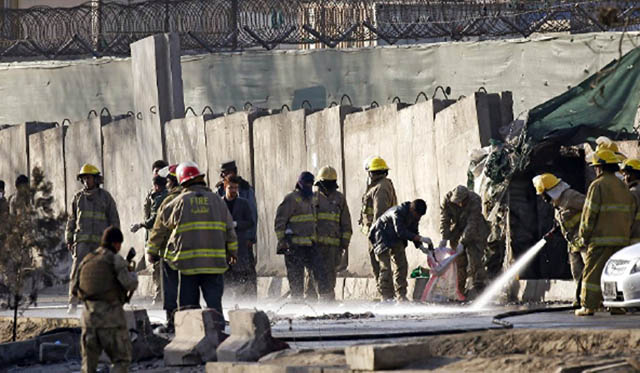According to the UN report, the number of civilian deaths and injuries in 2015 was the highest record since 2009 in Afghanistan, with children suffering on a large scale. There were 11,002 civilian casualties in 2015 including 3,545 deaths, the UN said in its annual report on civilians in armed conflict, a four per cent rise over the previous high in 2014. One in every four casualties was a child, with the report documenting a 14 per cent increase in child casualties over the year. “The harm done to civilians is totally unacceptable,” Nicholas Haysom, the UN’s special representative for Afghanistan, is cited as saying. “We call on those inflicting this pain on the people of Afghanistan to take concrete action to protect civilians and put a stop to the killing and maiming.”
Women also paid a heavy price, with a 37 per cent surge in female casualties. One in every ten casualties recorded was a woman, the report said. The document highlighted an increase in women being targeted for moral crimes, calling the executions and lashings a “disturbing trend”, and saying the UN plans to release a separate report on such incidents soon.
Militancy and terrorist attacks in populated areas and major cities were described as the main causes of civilian casualties in 2015, underscoring a push by Taliban militants into urban centers “with a high likelihood of causing civilian harm”, the report stated. Including Taliban-claimed attacks, the United Nations Assistance Mission in Afghanistan assigned responsibility for 62 per cent of total civilian casualties in 2015 to anti-government elements. However, the report also noted a surge in casualties caused by pro-government forces, including the international troops. Seventeen per cent of all casualties in 2015 were caused by such forces – a 28 per cent increase over 2014 – the report said. It was not possible to say which side caused the remaining 21 per cent of casualties.
The report documented a doubling of civilian casualties due to the deliberate targeting by militants of judges, prosecutors and judicial institutions. There were 188 such cases last year, of which 46 involved fatalities.
While ground engagements were the largest cause of civilian casualties, improvised explosive devices came second, the report said, adding that the use of such weaponry was in violation of international law and could constitute war crimes.
It reflects “a disconnect between commitments made and the harsh reality on the ground”, said the director of the UN’s human rights mission in Afghanistan, Danielle Bell.
Based on this report, the Taliban claimed 95 per cent of such targeted attacks. Indeed, the Taliban made heavy inroads in 2015. As a result, the Taliban insurgent group continued its “spring offensive” without cessation and captured Kunduz province on late September 2015 - the first time the extremists had managed to capture a major city since 2001. Similarly, they captured Sangin district of Helmand province and killed not only the civilians but also more than hundred of Afghan soldiers.
It is rightly said that “There isn’t a single Afghan family that hasn’t been affected by the daily acts of brutal and deadly terrorism carried out across our cities, towns, and villages. Our children – girls and boys – are attacked on their way to school and our mosques and public spaces are blown up all in the name of a noble religion, which in reality stands for peace and peaceful coexistence.”
Few days back, Zamir Kabulov, the Russian President’s special envoy for Afghanistan, said in a recent statement that the situation in Afghanistan remains tense, with “high or extraordinary” security threats present in 27 of the 34 Afghan provinces, as Taliban militants intensify their activities in different parts of the country. He also called the US and NATO mission in Afghanistan a complete failure. According to him, the ongoing “Decisive Support” training mission, which the US and their allies in Afghanistan are currently conducting, has also shown very little result. The Taliban also intend to spread radical ideology across the country more than ever before. It was reported earlier that the Taliban elements seek to spread warped ideology in Afghanistan via founding seminaries. With a new wave of privately run seminaries/madrasahs being opened across the country, there is a growing feeling among women’s rights groups that these freedoms are again under threat. Reportedly, there are now 1,300 unregistered madrasahs in Afghanistan, where children are given only religious teaching. This is increasing fears among those involved in mainstream education. Arguably the most controversial of these madrasahs is Ashraf-ul Madares in Kunduz, founded by two local senior clerics, where 6,000 girls study full time.
Moreover, Barack Obama has said: “…instability will continue for decades in many parts of the world – in the Middle East, in Afghanistan, parts of Pakistan, in parts of Central America, in Africa, and Asia. Some of these places may become safe havens for new terrorist networks. Others will just fall victim to ethnic conflict, or famine, feeding the next wave of refugees.”
Considering the Obama’s negative prediction and pessimistic statements over the security situation in Afghanistan, such casualties are not the last tragedy. To the people’s unmitigated chagrin, the Taliban’s militancy will continue and more people will lose their lives or succumb to injury. It is the government to tackle the issue and prevent from further casualties by hook or by crook –through negotiation or military action.
Home » Opinion » Civilians – The Victim of Terror
Civilians – The Victim of Terror
| Hujjatullah Zia

